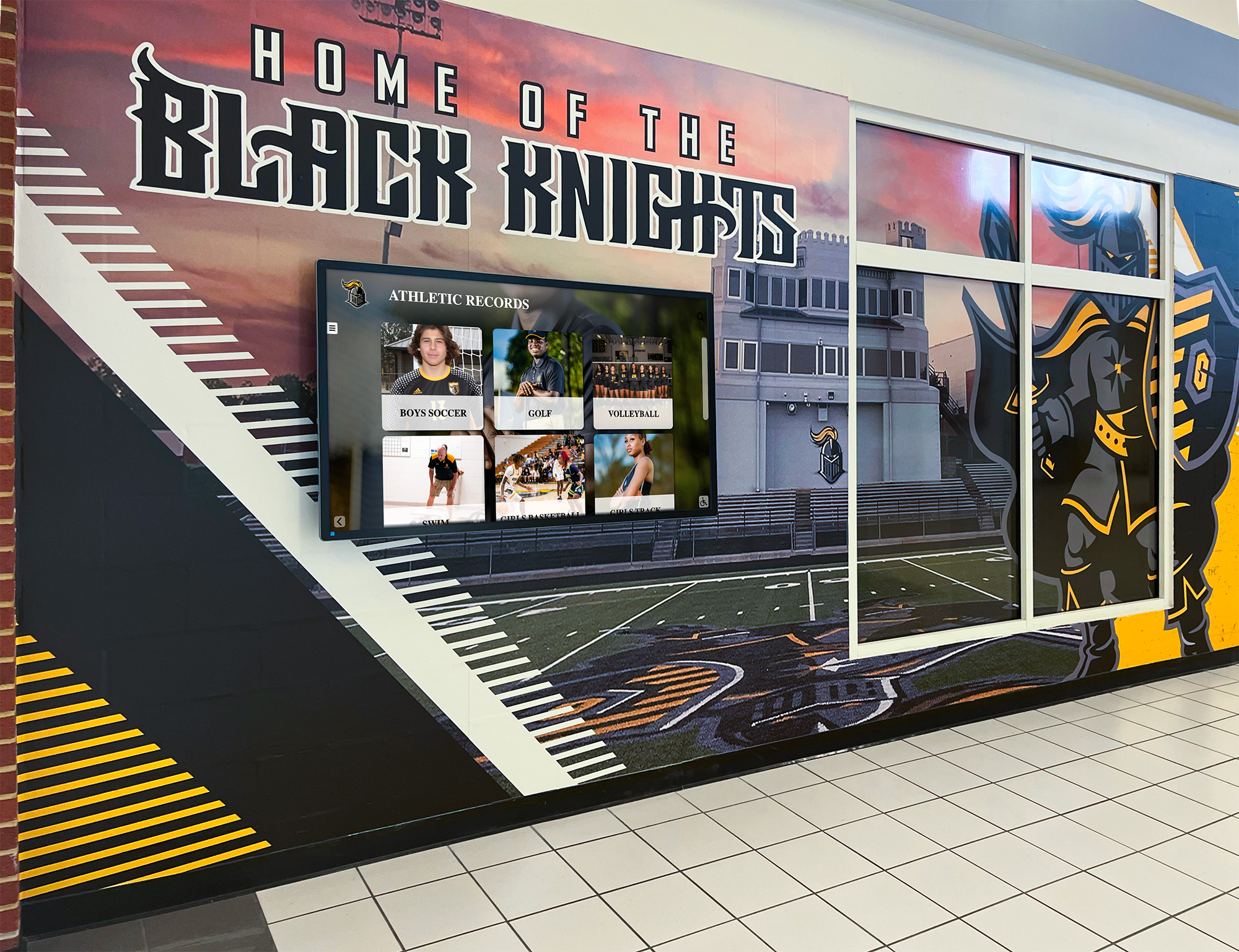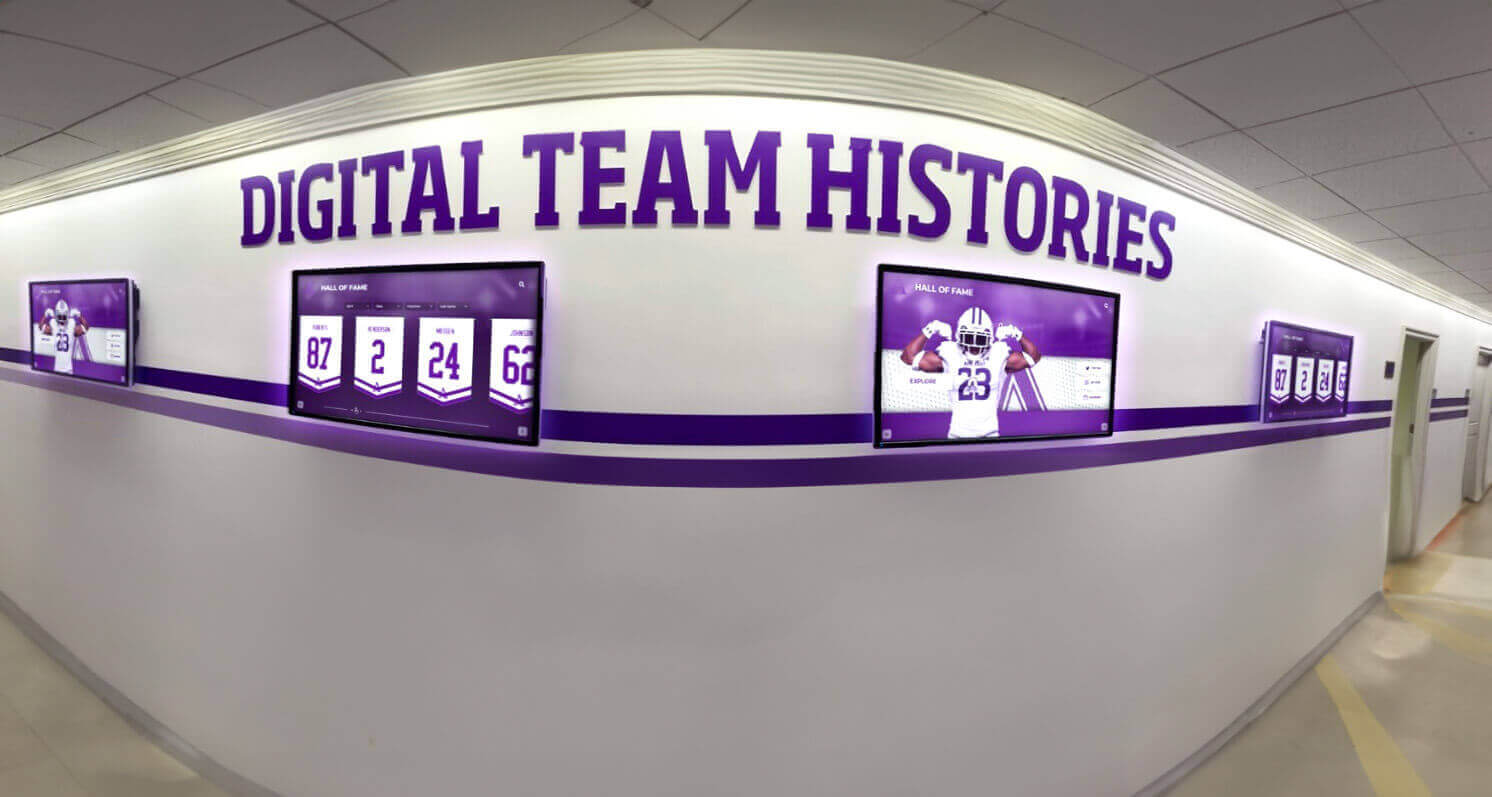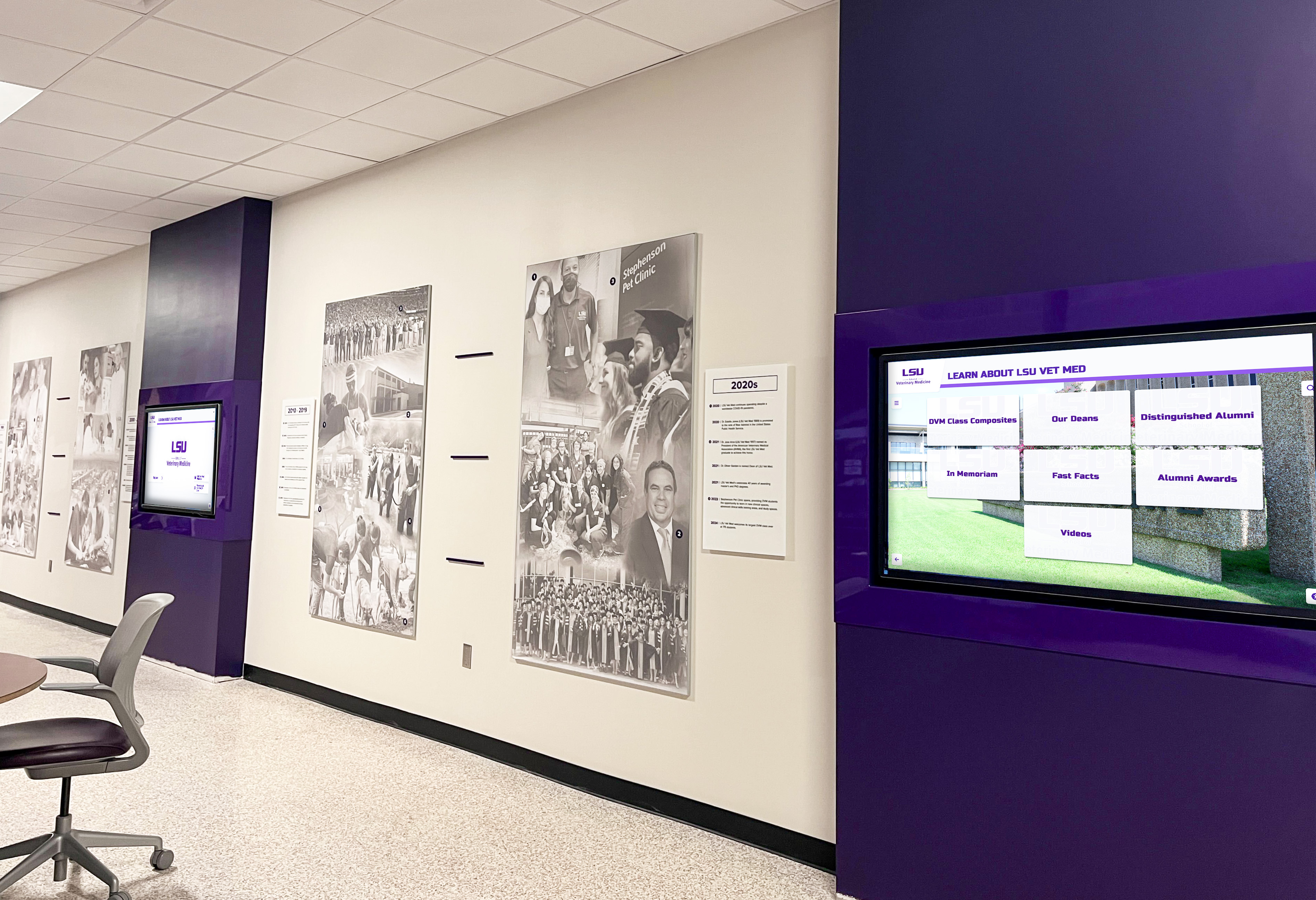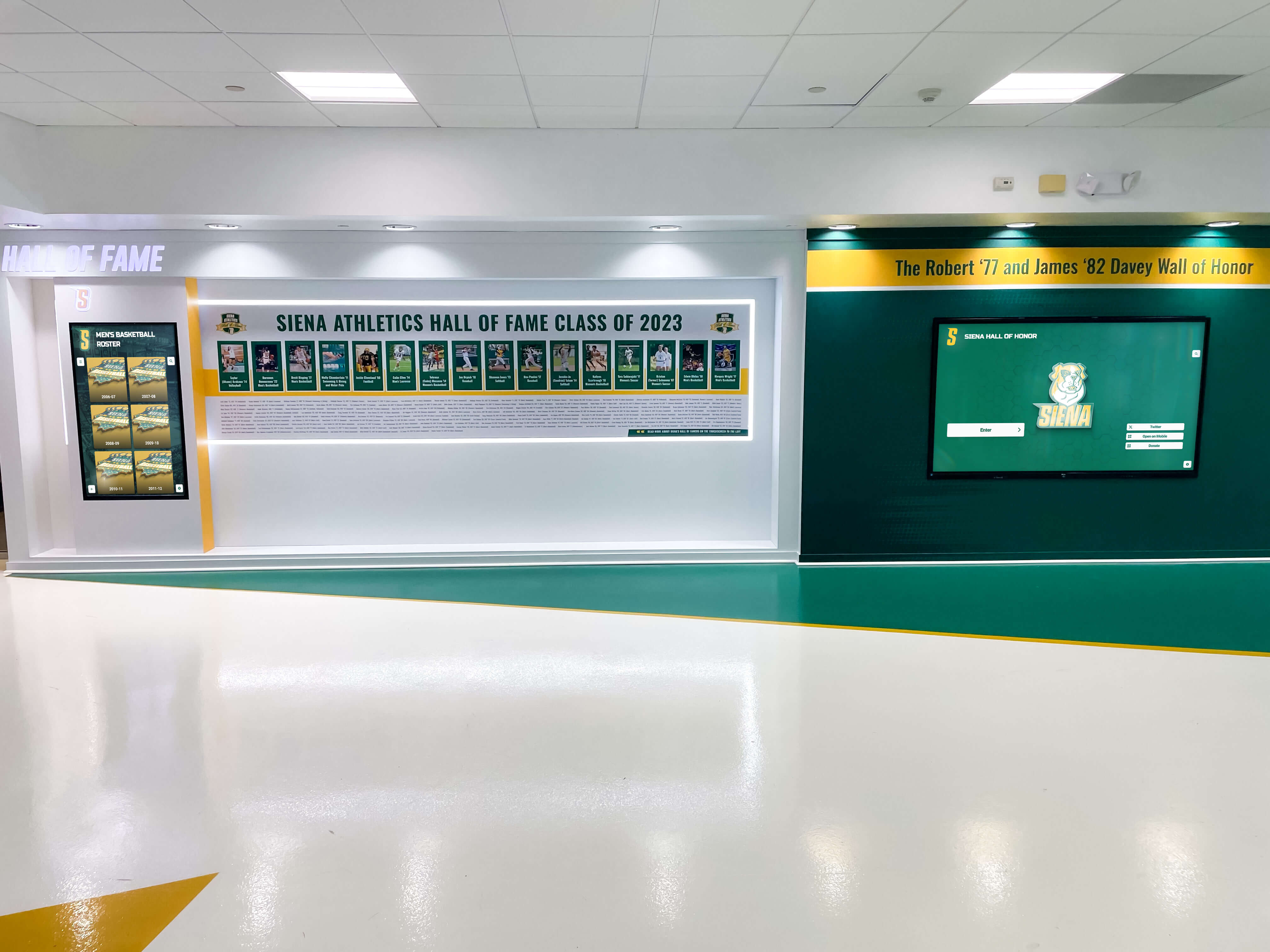When schools and organizations evaluate digital recognition solutions, they often encounter two fundamentally different approaches: traditional digital signage platforms like Rise Vision, and purpose-built interactive touchscreen systems like Rocket Alumni Solutions. While both involve displays mounted on walls, the similarity ends there. Understanding the critical differences between passive digital signage and interactive touchscreen recognition reveals why schools seeking meaningful engagement consistently choose interactive solutions over broadcast-style digital signage.
This comprehensive comparison examines Rise Vision’s digital signage approach against Rocket Alumni Solutions’ interactive touchscreen platform, clarifying why one technology excels at advertising and announcements while the other transforms how schools celebrate achievement and build community.
Understanding Rise Vision: Digital Signage for Announcements
Rise Vision positions itself as a digital signage platform primarily designed for schools to display announcements, schedules, lunch menus, and promotional content on screens throughout campuses. As of October 2025, based on publicly available information, the platform appears to focus on content rotation and broadcast rather than interactive engagement.
What Rise Vision Offers
According to their public materials, Rise Vision provides:
- Cloud-based content management for creating and scheduling displays
- Templates for common school announcements and information
- Multi-screen management across campuses
- Content scheduling for time-based displays
- Basic multimedia support for images and videos
The platform operates on a subscription model designed primarily for non-interactive digital signage use cases common in educational environments like hallway announcements, cafeteria menu boards, office directory displays, and event promotional screens.

Rise Vision’s Digital Signage Limitations
While Rise Vision may serve announcement and informational signage needs adequately, several fundamental limitations make it inappropriate for recognition displays requiring engagement and interactivity:
No Native Touchscreen Interaction
Rise Vision appears designed primarily for passive viewing rather than touch interaction. The platform broadcasts content that viewers watch, not experiences they explore. For recognition applications where users want to search for specific students, browse achievements by category, or explore detailed profiles, this lack of interactivity proves critically limiting.
Generic Content Templates
Digital signage platforms provide general-purpose templates designed for announcements and advertising rather than recognition-specific layouts. Schools attempting to adapt these generic templates for showcasing hall of fame inductees, athletic records, or alumni achievements find themselves constrained by designs never intended for comprehensive recognition storytelling.
Limited Engagement Capabilities
Passive digital signage that simply rotates slides generates minimal engagement. Studies consistently show that people glance at digital signage for mere seconds before moving on—adequate for reading lunch menus but insufficient for meaningful recognition that honors achievements appropriately. Without interactivity enabling personal exploration, viewers never develop the connection that makes recognition displays valuable.
Amateur Implementation Experience
Based on publicly available information as of October 2025, Rise Vision appears to be a relatively newer and less mature platform compared to established interactive touchscreen solutions. Organizations implementing digital signage often encounter challenges related to content design limitations, technical support availability, and feature maturity that more established platforms have refined through years of real-world deployments.
Why Rocket Alumni Solutions Excels for Interactive Recognition
Unlike digital signage platforms designed for broadcasting announcements, Rocket Alumni Solutions provides purpose-built interactive touchscreen software specifically engineered for recognition displays. This fundamental design difference results in dramatically superior outcomes for schools celebrating achievements.
Purpose-Built for Recognition and Engagement
Every aspect of Rocket’s platform serves recognition-specific needs:
Interactive Touch Navigation
Rocket’s software provides intuitive touchscreen interfaces enabling visitors to actively explore recognition content. Users can search for specific individuals, filter achievements by category or time period, browse through comprehensive databases, and view detailed profiles with photos and videos. This active engagement transforms recognition from passive viewing into personal exploration that visitors find compelling.
The distinction between passive digital signage and interactive touchscreen recognition displays fundamentally changes how people experience content. Rather than hoping viewers happen to see relevant content during brief glances, interactive systems let users discover exactly what interests them through intuitive exploration.

Comprehensive Recognition Profiles
Rocket enables rich, multimedia profiles showcasing achievements appropriately. Each inductee or award recipient receives dedicated profile pages featuring professional photos, biographical information, complete achievement descriptions, career highlights and accomplishments, video interviews and competition footage, and statistical records and performance data.
This depth of content proves impossible with digital signage platforms where everything competes for limited screen time in rotating content cycles. Interactive touchscreens provide unlimited space—a single 55-inch display showcases thousands of profiles accessible through intuitive search and navigation.
Searchable Achievement Databases
Rocket organizes recognition content in powerful searchable databases rather than linear slide sequences. Visitors can instantly locate specific individuals by typing names, filter achievements by sport, academic area, or recognition type, browse chronologically through institutional history, and discover connections between related achievements.
This searchability ensures every achievement receives equal recognition potential regardless of how many total inductees exist. Alumni returning for reunions can quickly find their graduation classes. Current students can locate role models in their activities. Parents can celebrate their children’s accomplishments. Digital signage rotating through hundreds of slides cannot provide this personalized access.
Professional Software Purpose-Built for Touchscreens
Rocket’s touchscreen software platform provides enterprise-grade capabilities specifically designed for recognition applications:
Intuitive Content Management
Cloud-based administration enables authorized staff to add new inductees, update existing profiles, upload photos and videos, schedule featured content, and publish changes instantly—all from any internet-connected device without requiring technical expertise.
Template-based content creation maintains visual consistency while streamlining development. Staff simply fill out forms with inductee information, upload photos, and publish. The system automatically formats content to match established design standards, eliminating the need for graphic design skills.
Mobile and Web Accessibility
Rocket extends recognition beyond physical displays through integrated web and mobile access. Complete recognition databases become accessible online, enabling alumni anywhere to explore institutional history. QR codes at physical displays connect visitors to extended content on personal devices. Social sharing features amplify recognition through personal networks.
This omnichannel approach maximizes recognition reach and impact far beyond what isolated digital signage screens provide.

Analytics and Engagement Tracking
Rocket provides comprehensive analytics revealing how visitors interact with recognition displays. Schools can track total interactions and unique users, average session duration indicating engagement depth, popular content and frequently searched terms, peak usage times informing content strategy, and navigation patterns revealing user behavior.
These insights enable data-driven optimization improving recognition effectiveness over time—capabilities digital signage platforms designed for broadcast rather than interaction typically lack.
Enterprise-Grade Reliability and Support
Rocket provides commercial-grade platform reliability with comprehensive support including 24/7 uptime monitoring and maintenance, regular feature updates and enhancements, responsive technical support, training and onboarding assistance, and long-term partnership relationships.
Organizations implementing recognition displays need partners committed to long-term success rather than vendors providing basic software subscriptions without ongoing engagement or platform evolution.
The Critical Difference: Passive Viewing vs Active Engagement
The fundamental distinction between digital signage and interactive touchscreens centers on engagement models—passive viewing versus active exploration.
Digital Signage: Broadcast Model
Traditional digital signage including platforms like Rise Vision operates on broadcast principles:
- Content rotates automatically on fixed schedules
- Viewers passively watch whatever happens to display
- Interaction consists of brief glances while passing
- All viewers see identical content regardless of interests
- Engagement typically measures in seconds
This broadcast model works adequately for announcements, menus, and promotional content where brief information delivery serves the purpose. However, recognition displays require fundamentally different engagement enabling personal connection with celebrated achievements.
Interactive Touchscreens: Exploration Model
Interactive touchscreen recognition systems like Rocket Alumni Solutions operate on exploration principles:
- Users actively control what they view and when
- Visitors engage for extended periods exploring content
- Interaction consists of purposeful discovery and search
- Each user creates personalized experiences based on interests
- Engagement typically measures in minutes
This exploration model creates meaningful recognition experiences. Alumni search for classmates and explore memories. Current students discover role models and institutional tradition. Visitors appreciate achievement depth impossible through passive viewing. Parents celebrate children’s accomplishments. This active engagement transforms recognition from information broadcast into community-building experiences.

Engagement Statistics: The Numbers Tell the Story
Studies of recognition display engagement reveal dramatic differences between passive digital signage and interactive touchscreens:
Digital Signage Engagement
- Average viewing time: 5-15 seconds
- Content recall: Low (passive observation)
- User satisfaction: Minimal (limited relevance)
- Repeat engagement: Rare (same content rotation)
Interactive Touchscreen Engagement
- Average session duration: 5-7 minutes
- Content recall: High (active exploration)
- User satisfaction: Strong (personalized relevance)
- Repeat engagement: Common (discovering new content)
These engagement differences translate directly to recognition effectiveness. Displays people explore for minutes create exponentially greater impact than screens they glance at for seconds.
Use Case Analysis: When Each Solution Makes Sense
Understanding appropriate applications for digital signage versus interactive touchscreens clarifies optimal technology selection.
Where Digital Signage Works Well
Digital signage platforms including Rise Vision serve certain applications effectively:
Announcements and Information
- Daily schedules and bell times
- Lunch menus and cafeteria information
- Upcoming events and deadlines
- Emergency notifications and alerts
- Directory and wayfinding information
Simple Promotional Content
- Club meeting announcements
- Athletic event promotion
- Fundraising campaign awareness
- College application reminders
These use cases require brief information delivery to passing viewers—exactly what digital signage provides.
Where Interactive Touchscreens Excel
Interactive recognition displays like Rocket Alumni Solutions transform applications requiring engagement:
Comprehensive Recognition Programs
- Hall of fame displays showcasing inductees
- Athletic record boards celebrating achievements
- Academic excellence recognition
- Alumni success story showcases
- Donor recognition and appreciation
Community Building Applications
- Historical archives and institutional legacy
- Alumni engagement and connection
- School pride and tradition celebration
- Recruitment and advancement marketing
- Storytelling and culture development
These applications require depth, searchability, personalization, and extended engagement—capabilities interactive touchscreens provide that digital signage fundamentally cannot deliver.

Technical Capabilities Comparison
Examining specific technical capabilities reveals fundamental differences between digital signage and interactive touchscreen platforms.
Content Management and Updates
Rise Vision (Digital Signage)
- Template-based slide creation for rotations
- Scheduled content publishing to displays
- Basic media libraries for assets
- Multi-screen content coordination
- Cloud-based content updates
Rocket Alumni Solutions (Interactive Touchscreens)
- Structured database for searchable profiles
- Real-time content updates without schedules
- Comprehensive media asset management
- Profile-based organization with relationships
- Advanced content workflows with approval
- Version control and content history
- Bulk import and export capabilities
Rocket’s structured approach enables comprehensive recognition databases while digital signage simply rotates slides.
User Interaction Capabilities
Rise Vision (Digital Signage)
- No native touch interaction (passive viewing)
- Linear content rotation on schedules
- No search or filtering capabilities
- No personalized experiences
- Limited to broadcast model
Rocket Alumni Solutions (Interactive Touchscreens)
- Multi-touch interactive navigation
- Powerful search across all content
- Dynamic filtering by multiple criteria
- Personalized discovery experiences
- Explore mode with active engagement
- Automatic attract mode when inactive
The difference between passive viewing and active exploration fundamentally determines recognition effectiveness.
Analytics and Measurement
Rise Vision (Digital Signage)
- Display online/offline status
- Content scheduling confirmation
- Basic system health monitoring
- Limited engagement metrics
Rocket Alumni Solutions (Interactive Touchscreens)
- Comprehensive interaction analytics
- Search query analysis and trends
- Session duration and depth metrics
- Popular content identification
- Navigation pattern analysis
- Peak usage time tracking
- Conversion and goal measurement
- Cross-display comparison reporting
Rocket’s analytics enable data-driven optimization while digital signage provides minimal insight into actual engagement.
Real-World Implementation Considerations
Beyond features and capabilities, practical implementation realities affect technology selection success.
Ease of Content Development
Digital Signage Challenges
Organizations implementing digital signage for recognition often struggle with content creation complexity. Converting rich achievement information into rotating slides that communicate effectively in brief viewing windows requires graphic design expertise. Maintaining visual consistency across hundreds of slides proves labor-intensive. Updating content requires recreating graphics rather than simple text edits.
Many schools attempting recognition displays with digital signage report that initial enthusiasm fades as content maintenance demands exceed available resources. What begins as an exciting project becomes an abandoned screen showing outdated information.
Interactive Touchscreen Advantages
Rocket’s structured content management eliminates design challenges. Staff simply enter information into forms—the system handles all formatting and presentation automatically. Adding a new hall of fame inductee takes minutes rather than the hours required for slide graphics creation. Updating information requires simple text edits rather than graphic recreation.
This ease of maintenance ensures recognition displays remain current and valuable long-term rather than becoming neglected installations.

Hardware Requirements and Costs
Digital Signage Approach
Digital signage runs on basic displays without touch capabilities, reducing hardware costs. However, the lack of interactivity limits recognition effectiveness regardless of cost savings. Organizations save money on hardware but sacrifice engagement that makes recognition displays valuable.
Interactive Touchscreen Approach
Interactive recognition requires commercial-grade touchscreen displays designed for extended public use. While hardware costs exceed basic digital signage screens, the engagement and functionality justify investment through actual results. Schools consistently report that interactive recognition displays deliver return on investment through enhanced community engagement, strengthened alumni connections, and cultural impact impossible with passive digital signage.
The appropriate comparison isn’t hardware cost but value delivered—where interactive touchscreens excel dramatically despite higher initial investment.
Long-Term Platform Maturity
Rise Vision Platform Maturity
Based on publicly available information as of October 2025, Rise Vision appears to be a relatively newer platform still developing its feature set and establishing market presence. Organizations selecting emerging platforms accept greater risk related to vendor stability, feature roadmap uncertainty, and support maturity compared to established solutions with proven track records.
Rocket Alumni Solutions Platform Maturity
Rocket Alumni Solutions has established itself through thousands of installations across educational institutions, athletic organizations, and corporate environments. This extensive deployment experience has refined the platform through real-world usage, comprehensive support infrastructure, and proven long-term vendor reliability.
Organizations selecting recognition display solutions benefit from choosing established vendors with demonstrated staying power and commitment to ongoing platform evolution.
Cost Analysis: Understanding Total Value
While Rise Vision may appear less expensive initially, comprehensive cost analysis reveals interactive touchscreens provide superior value through actual results.
Digital Signage Apparent Savings
Digital signage platforms typically charge lower subscription fees and require less expensive non-touch displays. However, these apparent savings often prove illusory when considering total costs including content development labor (creating and maintaining slide graphics), ongoing maintenance (recreating content for updates), opportunity costs (low engagement limiting recognition effectiveness), and replacement needs (deploying interactive solutions after digital signage fails to engage).
Many schools implementing digital signage for recognition find themselves replacing these systems with interactive touchscreens after discovering passive displays cannot deliver meaningful engagement.
Interactive Touchscreen Value Delivery
While interactive recognition displays require higher initial investment, comprehensive value analysis reveals superior return:
Tangible Benefits
- Dramatically increased engagement (minutes vs seconds)
- Unlimited recognition capacity (thousands of profiles)
- Easy content maintenance (minutes vs hours)
- Extended reach through web/mobile access
- Comprehensive analytics informing strategy
Strategic Benefits
- Enhanced school culture and pride
- Strengthened alumni engagement and giving
- Improved recruitment and marketing
- Community building and connection
- Institutional legacy preservation
Schools implementing digital recognition displays consistently report that interactive touchscreens deliver value far exceeding cost through measurable community impact impossible with passive digital signage.

Making the Right Choice for Your School
Schools evaluating recognition display solutions should consider several critical factors ensuring successful implementation.
Define Primary Objectives
Clarify what you want recognition displays to accomplish:
- Simple Announcements: Digital signage may suffice
- Meaningful Recognition: Interactive touchscreens essential
- Community Engagement: Interactive touchscreens required
- Alumni Connection: Interactive touchscreens with web access necessary
- Cultural Impact: Interactive touchscreens deliver transformational results
The more ambitious your recognition goals, the more essential interactive touchscreen capabilities become.
Evaluate Long-Term Sustainability
Consider ongoing operation realities:
- Who will maintain content and how frequently?
- What technical expertise is available internally?
- How important is ease of updates for long-term success?
- What level of vendor support and partnership is needed?
- How will platform capabilities need to evolve over time?
Interactive touchscreen platforms designed specifically for recognition provide sustainable long-term solutions while digital signage adapted for recognition often proves difficult to maintain effectively.
Consider Implementation Partnership
Technology selection represents only part of recognition display success. Implementation quality, ongoing support, content strategy, and vendor partnership prove equally important. Organizations implementing best practices for recognition displays achieve dramatically better results than those simply purchasing software and hardware.
Rocket Alumni Solutions provides comprehensive implementation partnerships including professional design services, content strategy development, staff training and support, ongoing platform evolution, and long-term success partnership—resources that generic digital signage vendors typically cannot offer.
Conclusion: Purpose-Built Solutions Deliver Superior Results
The comparison between Rise Vision digital signage and Rocket Alumni Solutions interactive touchscreens reveals fundamental differences in purpose, capability, and effectiveness. While digital signage platforms serve announcement and informational needs adequately, they fundamentally cannot deliver the engagement, interactivity, and depth required for meaningful recognition displays.
Rise Vision appears to be a digital signage platform designed for broadcasting announcements and promotional content—applications where passive viewing serves the purpose. The platform’s focus on content rotation and scheduled displays suits lunch menus and event promotion but proves inadequate for recognition requiring personal exploration, searchability, and extended engagement.
Organizations seeking to celebrate achievements, build community, honor alumni, and create cultural impact consistently choose purpose-built interactive touchscreen solutions like Rocket Alumni Solutions over generic digital signage platforms. The difference between passive viewing and active exploration determines whether recognition displays generate brief glances or meaningful engagement that honors achievements appropriately while building lasting community connections.
For schools and organizations ready to implement recognition displays that deliver genuine impact rather than simply occupying wall space, interactive touchscreens provide proven solutions specifically designed for these applications. The investment in purpose-built technology pays dividends through engagement metrics, community response, and cultural outcomes that passive digital signage simply cannot achieve.
Comparative Disclaimer: This comparison is based on publicly available information as of October 2025. All product names and trademarks are the property of their respective owners. Rocket Alumni Solutions is not affiliated with or endorsed by Rise Vision. Comparative statements reflect Rocket Alumni Solutions’ interpretation of available data and may change over time. This content was produced by or on behalf of Rocket Alumni Solutions.




































